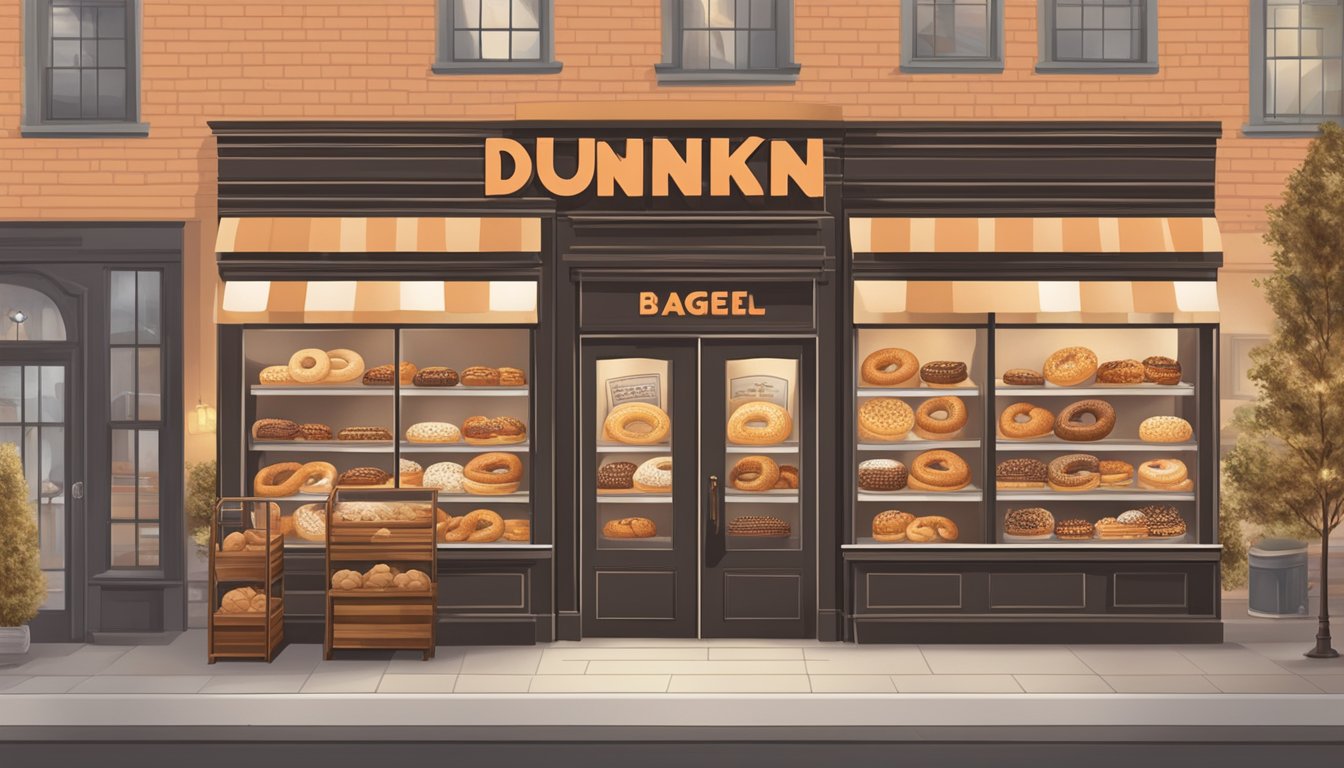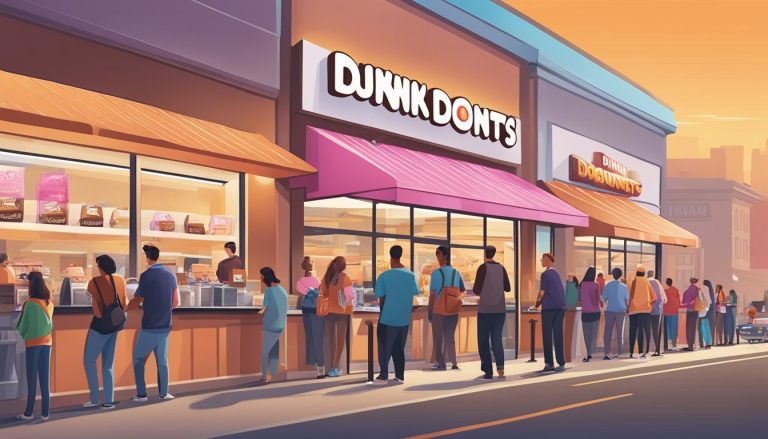Dunkin’, formerly known as Dunkin’ Donuts, has been a beloved American institution for decades. The company’s journey from a local coffee shop to a global powerhouse is marked by continuous innovation and menu expansion. Among its many offerings, bagels have played a significant role in Dunkin’s success story.
Dunkin’ introduced bagels to its menu in the 1970s, diversifying beyond its core donut and coffee offerings. This move was part of a broader strategy to compete with other breakfast chains and coffee shops. The addition of bagels allowed Dunkin’ to appeal to a wider range of customers and solidify its position as a go-to destination for morning meals.
Over the years, Dunkin’ has continued to innovate with its bagel offerings. The company has introduced various flavors and toppings, catering to changing consumer tastes. This commitment to quality and variety has helped Dunkin’ maintain its popularity in the competitive breakfast market. The success of bagels, along with other menu items, contributed to the brand’s iconic “America Runs on Dunkin'” slogan, which debuted in 2006 and reinforced the company’s status as a staple of American daily life.
The Origins of Dunkin’ Donuts

Dunkin’ Donuts began as a small restaurant in Quincy, Massachusetts, founded by William Rosenberg. The business quickly evolved from its initial concept to become a well-known brand.
William Rosenberg’s Vision
William Rosenberg, an entrepreneur with a keen eye for customer needs, opened a restaurant called “Open Kettle” in 1948. Located in Quincy, Massachusetts, the establishment served donuts for five cents and premium coffee for ten cents. Rosenberg’s focus on quality and affordability resonated with customers.
His business acumen led him to recognize the potential for growth in the food service industry. Rosenberg’s vision extended beyond a single location, as he aimed to create a chain of restaurants that could replicate his successful formula.
Open Kettle to Dunkin’ Donuts
In 1950, Rosenberg and his executives brainstormed ideas to rebrand the restaurant. They chose the name “Dunkin’ Donuts,” which reflected the act of dunking donuts in coffee – a popular customer habit.
The first official Dunkin’ Donuts opened its doors in 1950, marking the beginning of a new era. The menu focused on coffee and donuts, with an emphasis on variety and freshness. Customers could watch bakers prepare donuts on-site, adding to the appeal of the brand.
Rosenberg’s decision to franchise the business came from observing Howard Johnson’s successful ice cream store model. This strategic move allowed Dunkin’ Donuts to expand rapidly across Massachusetts, opening locations in Somerville, Natick, Saugus, and Shrewsbury.
Dunkin’s Expansion and Franchising

Dunkin’ leveraged franchising to fuel rapid growth across the United States and internationally. This strategy allowed the company to expand its footprint while maintaining consistent quality and brand standards.
National Growth
Dunkin’ began franchising in 1955, opening its first franchise location in Worcester, Massachusetts. This move marked the start of a nationwide expansion. By 1963, Dunkin’ had grown to over 100 locations across the country.
The company’s focus on franchising allowed for quick expansion with reduced capital investment. Dunkin’ carefully selected franchisees who shared their vision for quality and customer service. This approach helped maintain brand consistency as the chain grew.
Throughout the 1970s and 1980s, Dunkin’ continued its rapid expansion. The company introduced new menu items like muffins and bagels to appeal to changing consumer tastes. By the 1990s, Dunkin’ had established itself as a major player in the quick-service restaurant industry.
Going Global
Dunkin’ began its international expansion in the 1970s. The company opened its first international location in Japan in 1970. This move marked the beginning of Dunkin’s global presence.
Over the following decades, Dunkin’ expanded into numerous countries across Asia, Europe, and Latin America. The company adapted its menu and store designs to suit local tastes and preferences in each market.
By the early 2000s, Dunkin’ had established a strong international presence. The company’s global expansion strategy focused on partnering with local franchisees who understood their respective markets. This approach helped Dunkin’ navigate cultural differences and regulatory challenges in new countries.
Franchise Agreements and Partnerships
Dunkin’ developed a comprehensive franchise model to support its expansion. The company provided franchisees with training, marketing support, and operational guidance. This ensured consistency across locations while allowing for local adaptations.
Franchise agreements typically included requirements for store design, menu offerings, and quality standards. Dunkin’ also established partnerships with suppliers to maintain product consistency across its growing network.
In some international markets, Dunkin’ formed joint ventures or master franchise agreements. These partnerships allowed for more rapid expansion in new regions. The company worked closely with local partners to adapt its offerings and business model to suit each market’s unique characteristics.
Introduction of Bagels to the Menu

Dunkin’ expanded its menu offerings in 1996 by introducing freshly-baked bagels. This move marked a significant shift in the company’s product lineup and breakfast strategy.
Product Innovation and Menu Diversification
Dunkin’ launched bagels as part of its menu diversification efforts. The company aimed to compete with other breakfast chains and appeal to a wider customer base. Bagels were offered in various flavors, including plain, sesame, and everything.
Dunkin’ also introduced bagel twists in 2010. These twisted bagels provided a more portable option for on-the-go customers. The innovation demonstrated Dunkin’s commitment to adapting its products to changing consumer needs.
Bagel as a Breakfast Staple
Bagels quickly became a popular breakfast item at Dunkin’. The company leveraged its bakery expertise to produce fresh bagels daily in its stores. This commitment to quality helped establish bagels as a core part of Dunkin’s breakfast menu.
Dunkin’ expanded its bagel offerings to include breakfast sandwiches. These sandwiches featured various fillings like eggs, cheese, and bacon on bagels. The combination of bagels with traditional breakfast ingredients created a convenient and satisfying meal option for customers.
Dunkin’s Impact on Quick Service Industry

Dunkin’ revolutionized the quick service restaurant landscape, particularly in New England. The brand’s focus on speed, convenience, and quality transformed customer expectations and industry practices.
Convenience and Efficiency
Dunkin’ pioneered drive-thru service for coffee and baked goods. This innovation significantly reduced wait times and increased accessibility for busy customers. The company’s efficient store layouts and streamlined ordering processes became industry benchmarks.
Dunkin’ also expanded its menu strategically. While maintaining its core offerings, it introduced new items to cater to changing tastes. This balance allowed for quick service without compromising quality.
The brand’s widespread presence, especially in New England, made it a convenient stop for millions. Dunkin’ outlets in high-traffic areas and transportation hubs further solidified its position as a go-to option for on-the-go consumers.
Loyalty Programs and Customer Experience
Dunkin’s DD Perks program set new standards in the quick service industry. The program offered personalized rewards, encouraging repeat visits and increasing customer engagement.
The loyalty program provided valuable data on consumer preferences. This information helped Dunkin’ tailor its offerings and marketing strategies effectively.
Dunkin’ focused on creating a welcoming atmosphere in its stores. Friendly staff, clean environments, and consistent product quality became hallmarks of the Dunkin’ experience.
The brand’s emphasis on affordable prices without compromising quality resonated with a broad customer base. This approach influenced pricing strategies across the quick service sector.
Adaptation to Technology and Mobile Ordering
Dunkin’ embraced digital technology early, launching its mobile app in 2012. The app streamlined ordering processes and reduced in-store wait times.
The company’s integration of mobile payments enhanced convenience for tech-savvy customers. This move prompted other quick service chains to accelerate their digital transformation efforts.
Dunkin’s adoption of digital menu boards in stores improved order accuracy and allowed for dynamic menu updates. This technology became a standard feature in many quick service restaurants.
The brand’s investment in data analytics improved inventory management and customer targeting. These practices set new benchmarks for operational efficiency in the industry.
Marketing and Brand Reputation

Dunkin’ has leveraged clever marketing strategies and strong brand recognition to cement its position in the competitive coffee and baked goods industry. The company’s approach combines memorable slogans with targeted campaigns to appeal to a wide customer base.
Slogan and Brand Recognition
Dunkin’ adopted the iconic slogan “America Runs on Dunkin'” in 2006. This catchy phrase quickly became synonymous with the brand, emphasizing Dunkin’s role in fueling Americans’ daily routines. The slogan’s success stems from its simplicity and relatability, resonating with customers across diverse demographics.
Dunkin’s orange and pink color scheme, introduced by founder Bill Rosenberg, has become instantly recognizable. This distinct visual branding helps Dunkin’ stand out in crowded markets and reinforces brand loyalty among consumers.
Targeted Campaigns and Rebranding Strategies
In 2018, Dunkin’ Donuts officially rebranded to simply “Dunkin'”. This strategic move aimed to highlight the brand’s expanding beverage offerings beyond donuts. The rebranding included updated store designs and new product innovations to appeal to changing consumer preferences.
Dunkin’ has embraced digital marketing and social media to reach younger audiences. Collaborations with influencers, like TikTok star Charli D’Amelio, have proven highly effective. The “The Charli” drink campaign resulted in significant sales increases, demonstrating the power of targeted marketing in driving customer engagement and sales growth.
Community and Corporate Responsibility

Dunkin’ has demonstrated a commitment to social responsibility through various initiatives and partnerships. The company focuses on addressing food insecurity and environmental concerns.
Collaborations with Food Banks
Dunkin’ partners with local food banks to combat hunger in communities across the United States. The company donates surplus food products, including bagels and pastries, to organizations that distribute meals to those in need. In 2020, Dunkin’ launched its “Fuel Our Heroes” program, providing free coffee and donuts to healthcare workers during the COVID-19 pandemic.
Dunkin’ also encourages its franchisees to participate in food donation programs. Many locations work directly with nearby food banks to provide regular contributions. This effort helps reduce food waste while supporting vulnerable populations in the areas where Dunkin’ operates.
Environmental Initiatives and Partnerships
Dunkin’ has taken steps to reduce its environmental impact through various initiatives. In 2014, the company transitioned U.S. Dunkin’ bagel bags to 100% recycled paper, demonstrating a commitment to sustainable packaging.
The quick-service restaurant chain has also partnered with environmental organizations to improve its practices. Dunkin’ works with the Rainforest Alliance to source sustainably grown coffee beans. This collaboration ensures that their coffee production supports biodiversity conservation and improves farmers’ livelihoods.
Dunkin’ has set goals to eliminate foam cups and replace them with double-walled paper cups. This initiative aims to remove a billion foam cups from the waste stream annually, significantly reducing the company’s environmental footprint.
The Evolution of Dunkin’s Product Range
Dunkin’ has continuously expanded its menu offerings beyond its original donut focus. This evolution has included the introduction of new product lines and specialty items to cater to changing consumer tastes.
Launch of New Products
Dunkin’ began diversifying its menu in the 1990s. The company introduced bagels in 1996, meeting customer demand for more breakfast options. In 1997, Dunkin’ added a line of breakfast sandwiches, further solidifying its position as a quick-service breakfast destination.
The early 2000s saw Dunkin’ enter the specialty coffee market. Espresso-based drinks like lattes and cappuccinos were added to the menu, allowing Dunkin’ to compete with coffee giants like Starbucks. This move was encapsulated in their 2006 slogan “America Runs on Dunkin’.”
Dunkin’ has also embraced healthier options. Whole wheat bagels, reduced fat muffins, and egg white breakfast sandwiches were introduced to appeal to health-conscious consumers.
Specialty Items: The Coolatta and Munchkins
In 1997, Dunkin’ launched the Coolatta, a frozen beverage line that quickly became popular. Available in various flavors, Coolattas provided a refreshing alternative to hot coffee drinks, especially during summer months.
Munchkins, Dunkin’s donut hole treats, were introduced in 1972. These bite-sized treats became an instant hit, perfect for sharing and on-the-go snacking. Munchkins are available in various flavors, mirroring Dunkin’s full-sized donut offerings.
The success of Coolattas and Munchkins demonstrated Dunkin’s ability to innovate beyond its core donut and coffee products. These specialty items have become beloved staples of the Dunkin’ menu, contributing to the brand’s identity as more than just a donut shop.
Conclusion

Dunkin’ has made a significant impact on the bagel market since introducing them to their menu. Their commitment to innovation and quality has kept bagels a popular offering for decades.
Menu innovation remains a key focus for Dunkin’. They regularly introduce new bagel flavors and toppings to appeal to changing consumer tastes.
The company’s bagels have become an integral part of their “America runs on Dunkin'” slogan. For many, a Dunkin’ bagel is now as iconic as their donuts and coffee.
Dunkin’ continues to refine their bagel recipes and production methods. This ensures consistent quality across their thousands of locations nationwide.
As Dunkin’ expands globally, their bagels are introducing international customers to this quintessential American breakfast item. The humble bagel has become an ambassador for the brand worldwide.




